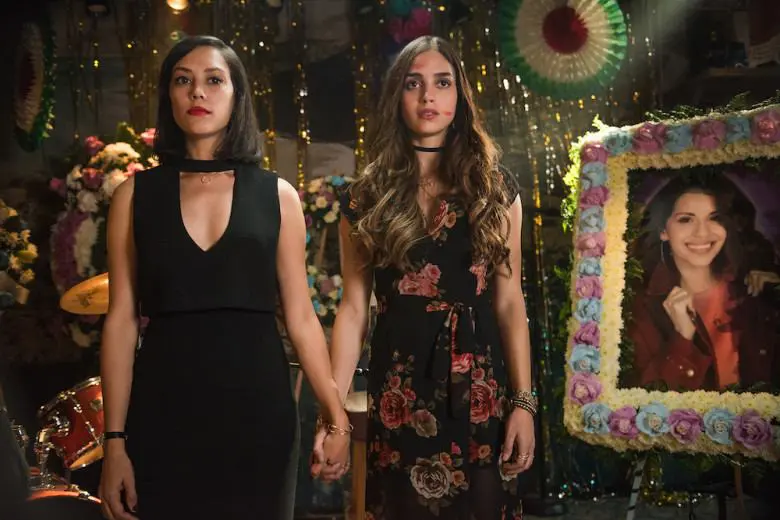Summary
Thus far, Vida is quite unlike anything else on television, and while I’m not at all within its target demographic, that’s the show’s greatest strength.
Vida, debuted around the same time as Sweetbitter but is thankfully much, much better, is something of a minefield – for me, anyway. It’s about, at least in part, gentrification in an East Los Angeles neighborhood (I’m from England), focusing on two Mexican-American sisters (I’m white and male) who return to their primarily Latinx neighbourhood (I had no idea that there was a gender-neutral substitute for Latino/Latina) in the wake of their mother’s death.
It also incorporates a lot of characters and issues that fall under the LGBTQ umbrella, which, just to complete this fun round of white privilege bingo, is not an umbrella that accommodates me.
Still, we’re short-staffed on the TV front, and I have bills to pay, so what is to be done? Hence, I watch Vida. And I very much enjoy Vida despite it quite obviously not being made for or marketed towards people like me; despite, in fact, people like me – white, straight, etc. – being something of a villain in the eyes of Tanya Saracho, the show’s creator, and her Latinx-only writers room.
Don’t feel sorry for me. I’m from a country that at one point in time forcibly owned almost every other country in the world, and I make a living writing unnecessarily mean-spirited things about other people’s hard work, so I probably deserve the ire.
Besides, I’m sure what you want to know is whether or not you should be watching Vida, which despite all it’s wonderful qualities I haven’t seen being pushed too hard on my various social media timelines. So, let’s get on with that.
The answer, perhaps unsurprisingly at this point, is yes, you should be watching Vida. I’d even say that you should be watching it regardless of your gender, ethnic background or sexual orientation, although you’ll obviously get more out of it if you’re in one of the disenfranchised groups it so fiercely represents.
But it’s just a damn good show any way you slice it; thoughtful without being dreary, righteous without being combative, inclusive without pandering, and with a vivid sense of a place that has all the specificity and complexity of home – not mine, you understand, but someone else’s. Maybe even yours.
Emma (Mishel Prada) is the older of the two sisters, a careerist and (it’s strongly implied) a closeted lesbian who lives in Chicago and is estranged from her mother, Vidalia, and her sister, Lyn (Melissa Barrera). This is made pretty clear in the first episode when Lyn asks if she can keep her “cuntiness” in check for at least the duration of her mother’s funeral, the wake of which is held at the bar formerly owned by Vida and now managed by her widow, Eddy (Ser Anzoategui).
Emma wants to sell the building, at first to an openly predatory developer who is basically gentrification given flesh, but over the course of the first two episodes that swiftly proves a terrible idea. And thus, Emma and Lyn resolve to stay in town a little while longer.
What complicates this is that, given they both relocated to less racially-specific climes, Emma and Lyn are essentially outsiders in the neighbourhood they grew up in. In a sense, they expect things to be the same; Emma likes to eat at an old spot, airs and graces be damned, and Lyn still clearly has the hots for her ex, Johnny (Carlos Miranda), who now has a pregnant fiancé.
But they can’t reintegrate themselves quite so easily. In leaving, they left the neighbourhood to be sculpted in a newer, whiter image, stripped of its cultural personality by faceless urban renewal. Those who stayed resent them for it, particularly Marisol (Chelsea Rendon), a young vlogging activist (aren’t they all?) who calls them scathing slang terms for those who have abandoned their Mexican roots for a more stereotypically “white” identity.
She also happens to be Johnny’s little sister, and has a funny scene where she spray-paints “Fuck White Art” on a new gallery and harasses a nearby hipster.

(Credit: Starz)
If this sounds irritatingly didactic, fear not. Vida is written in a way that uses social and cultural subtext to colour personal stories, rather than having its characters spout idle rhetoric just for the sake of it. There’s a sense in these first two episodes of Emma and Lyn being archetypes; the cold businesswoman and the younger, looser sister, who defines herself mostly by whichever man happens to be in her life at the time.
And that’s not inaccurate, but over the course of an hour (each episode runs 30 minutes) the performances and the sharp writing and the well-observed details override those first impressions.
I’d like to know more about Eddy, who feels particularly underserved by the script, and I hope the time is taken to flesh out Marisol beyond a rather one-note mouthpiece for social issues, and I hope, although I can’t believe I’m saying so, that Lyn stops having sex every episode, just to free up some of the scant running time.
A lot of Vida is devoted to sex scenes, all of them so far involving Lyn, and while she’s a very attractive woman, that’s kind of the issue – those scenes feel as if they’re there to please me instead of further the story.
Still, Vida, very much to its credit, only rarely feels like it’s doing anything for me, which is something I appreciate. The media I consume has catered to me my whole life, and while I enjoy being catered to, as anyone should, I also find it useful when a show or a book or a film or simply a person opens a window into a culture I hadn’t previously been exposed to.
Knowledge is good. Diversity is good. Understanding is good. Vida feels like it’s trying to provide all of those things, and thus far, it’s doing so. After all, why not?
Read More: Vida Season 1, Episode 3 Recap




